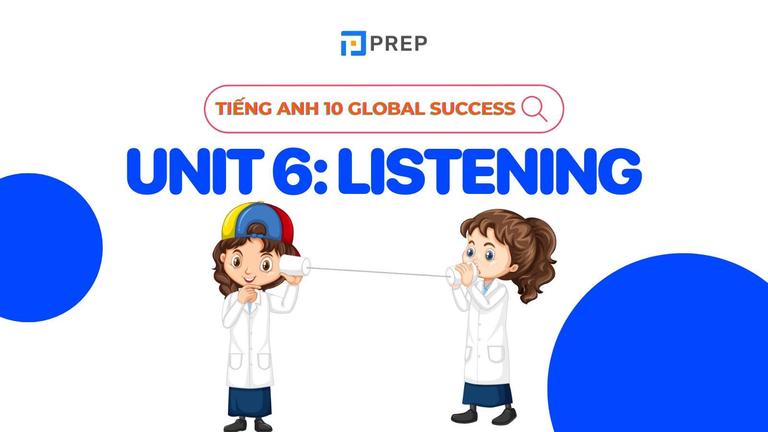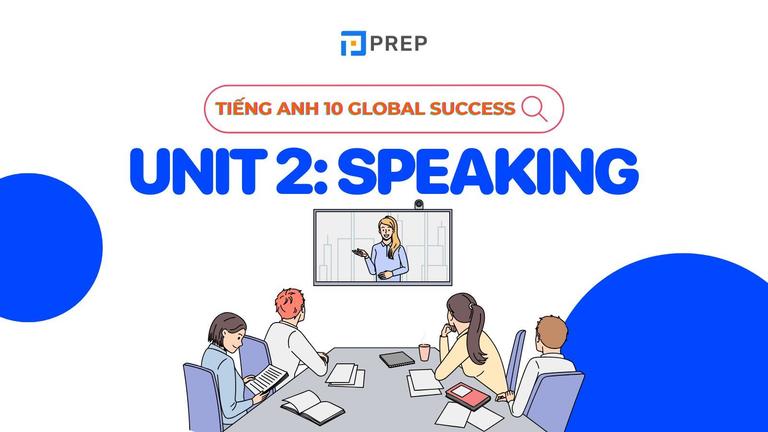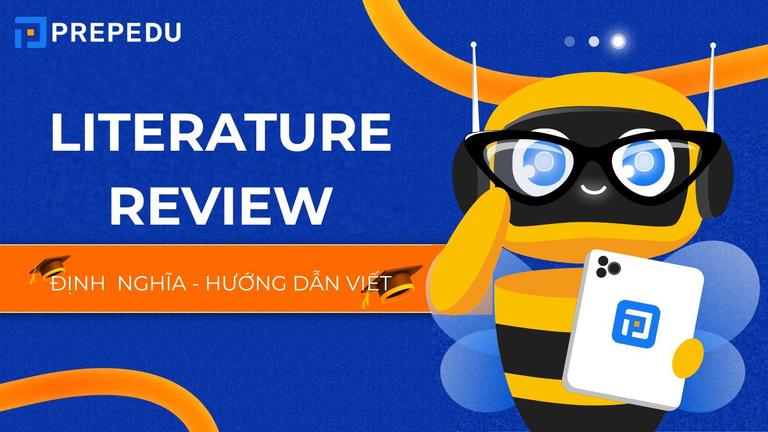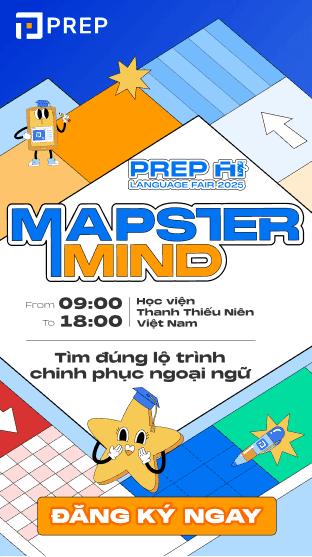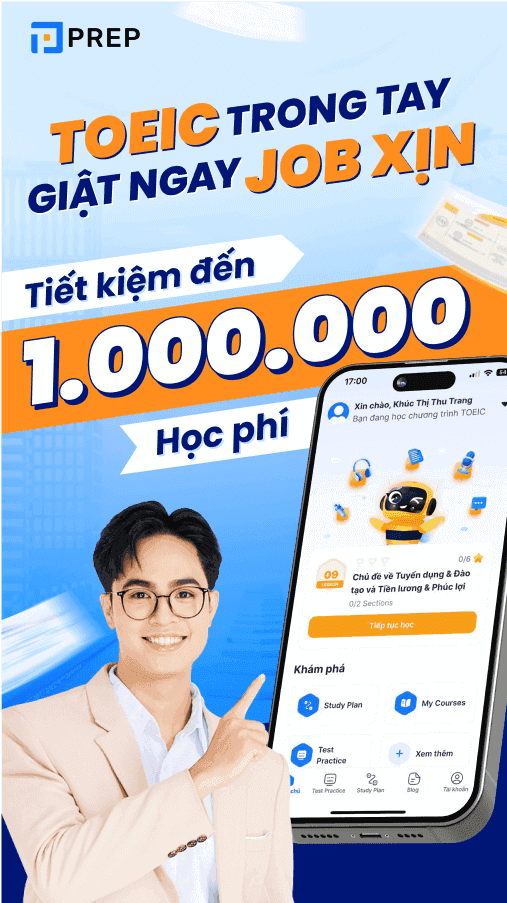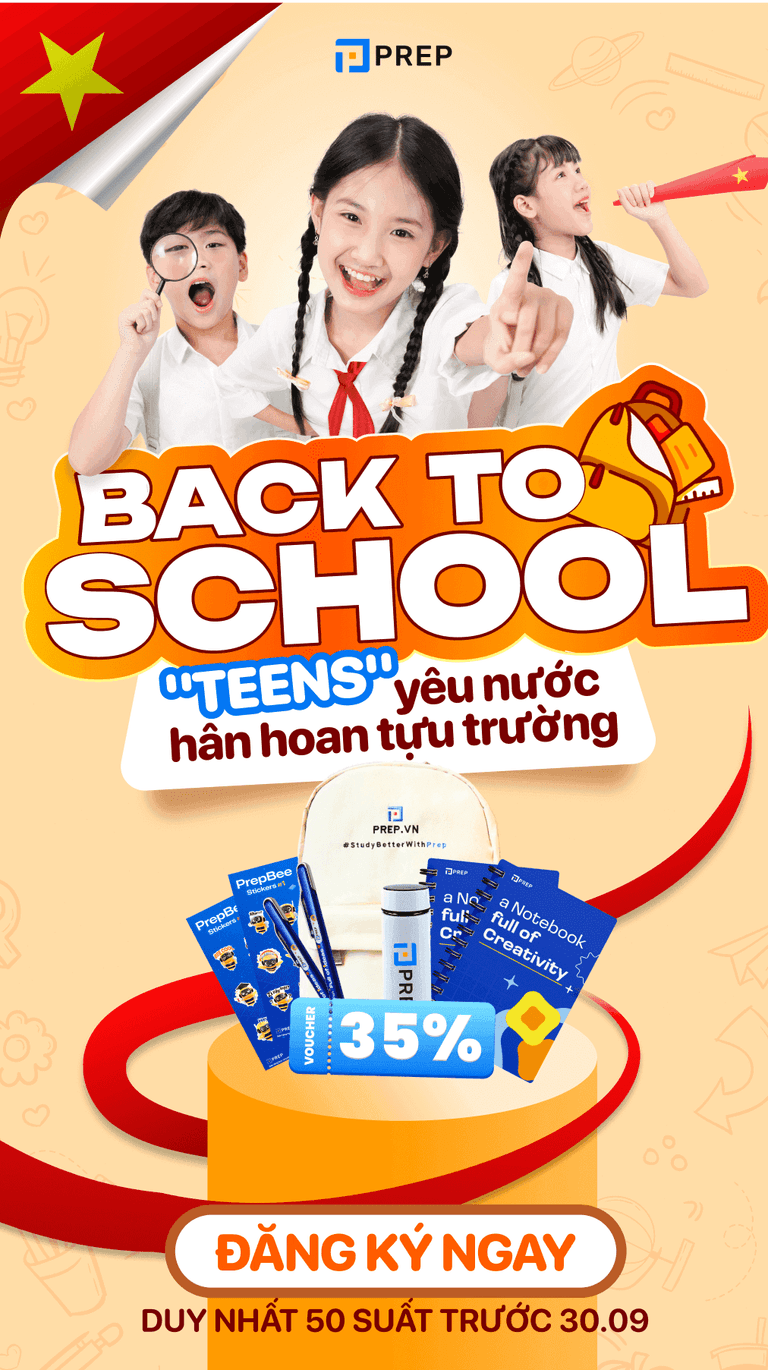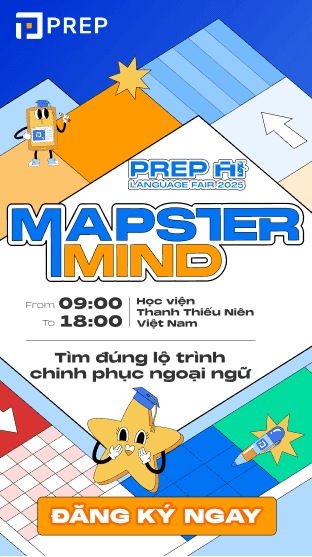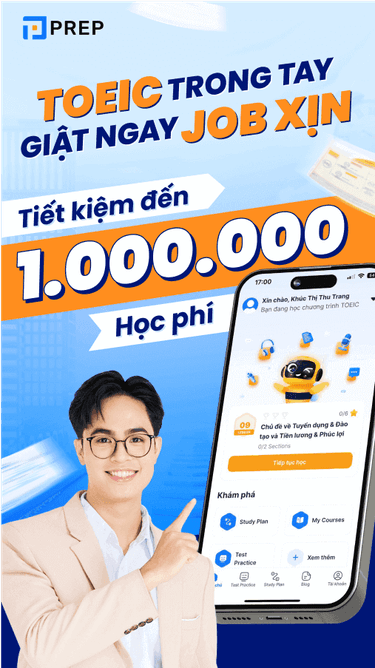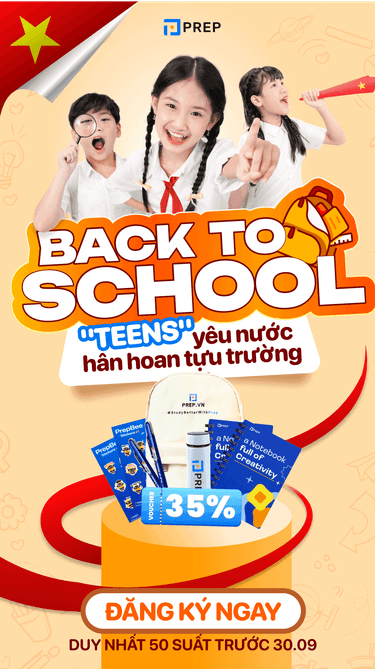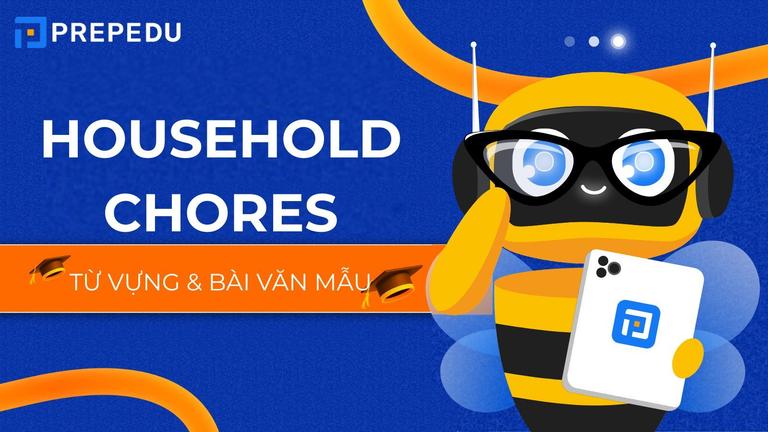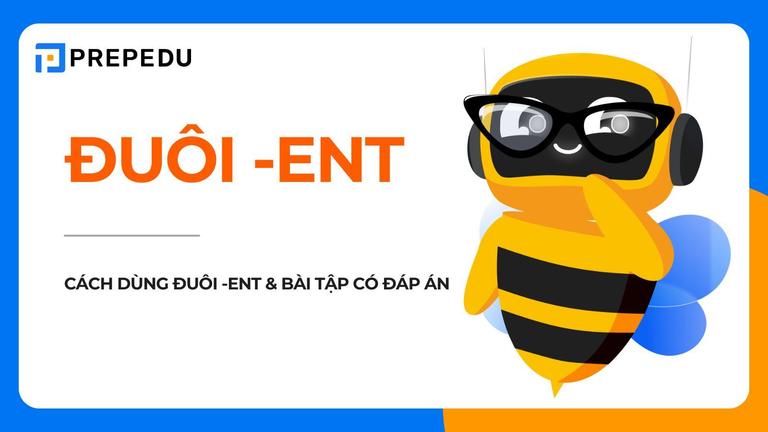Tổng hợp bài tập đọc hiểu tiếng Anh từ cơ bản đến nâng cao có đáp án
Kỹ năng đọc hiểu (Reading Comprehension) là một phần không thể thiếu trong các kỳ thi tiếng Anh, đặc biệt là các kỳ thi chuẩn hóa như THPT Quốc gia, TOEIC, IELTS,.... Tuy nhiên, không ít học sinh gặp khó khăn trong việc nắm bắt ý chính, suy luận logic hay xác định từ vựng trong ngữ cảnh. Vì vậy, việc luyện tập thường xuyên với các bài đọc hiểu kèm đáp án và lời giải chi tiết là một phương pháp hiệu quả để nâng cao kỹ năng đọc, củng cố từ vựng và cải thiện điểm số.
Bài viết này PREP tổng hợp bài tập đọc hiểu tiếng Anh đa dạng về chủ đề và mức độ, đi kèm đáp án cũng như lời giải chi tiết cho từng câu hỏi. Từ đó, người học có thể không chỉ kiểm tra khả năng hiện tại mà còn hiểu rõ vì sao một lựa chọn là đúng — một yếu tố quan trọng giúp nâng cao tư duy phản biện và chiến lược làm bài.

I. Bài tập đọc hiểu tiếng Anh cơ bản - nâng cao
Hãy cùng PREP luyện tập các bài tập đọc hiểu cho mọi trình độ, từ cơ bản đến nâng cao, để nâng cao kỹ năng và tối đa hóa điểm số nhé!
1. Bài tập đọc hiểu tiếng Anh cơ bản
1.1. Bài 1: Online Learning Revolution

Đọc đoạn văn sau và trả lời các câu hỏi:
Online learning has become increasingly popular in recent years, especially after the global pandemic. Many students now prefer studying from home because it offers flexibility and convenience. They can learn at their own pace and choose when to study, which is perfect for people with busy schedules.
However, online learning also has some challenges. Students need strong self-discipline to stay motivated without a teacher physically present. Technical problems like poor internet connection can interrupt classes. Additionally, some subjects, particularly those requiring hands-on practice like science experiments or art projects, are difficult to teach effectively online.
Despite these challenges, educational technology continues to improve. Interactive videos, virtual classrooms, and AI-powered learning tools are making online education more engaging. Many universities and schools now offer hybrid programs that combine online and in-person learning, giving students the best of both worlds.
The future of education will likely include more online elements. Students who adapt to this change and develop good online learning habits will have advantages in their academic and professional careers.
Questions:
-
What is the main idea of the passage?
A. Online learning is better than traditional learning
B. The growth and impact of online learning
C. Technical problems in online education
D. The future of universities
-
According to the passage, online learning is popular because it offers:
A. better teachers
B. cheaper courses
C. flexibility and convenience
D. more social interaction
-
The word "discipline" in paragraph 2 is closest in meaning to:
A. punishment B. subject C. self-control D. difficulty
-
Which subjects are mentioned as difficult to teach online?
A. Mathematics and literature
B. Science experiments and art projects
C. History and geography
D. Foreign languages
-
What can be inferred about the future of education?
A. All learning will be completely online
B. Traditional classrooms will disappear
C. Online and offline learning will be combined
D. Technology will replace all teachers
1.2. Bài 2: The Benefits of Regular Exercise
Đọc đoạn văn sau và trả lời các câu hỏi:
Regular exercise is one of the most important things you can do for your health. It helps control your weight, reduces the risk of heart disease, and strengthens your bones and muscles. Exercise also improves your mental health by reducing stress and anxiety.
You don't need to spend hours at the gym to get these benefits. Even 30 minutes of moderate activity most days of the week can make a big difference. Simple activities like walking, swimming, or cycling are excellent choices for beginners. The key is to find activities you enjoy so that exercise becomes a habit rather than a chore.
Many people think they don't have time to exercise, but this is often just an excuse. You can easily fit physical activity into your daily routine. Take the stairs instead of the elevator, walk or cycle to work, or do some stretching exercises while watching TV. Small changes in your daily habits can lead to significant health improvements.
Starting an exercise routine can be challenging, but the benefits are worth it. Begin slowly and gradually increase the intensity and duration of your workouts. Remember to consult with a doctor before starting any new exercise program, especially if you have health concerns.
Questions:
-
According to the passage, regular exercise helps with all of the following EXCEPT:
A. weight control
B. heart disease prevention
C. improving memory
D. reducing stress
-
How much exercise does the passage recommend?
A. Several hours daily
B. 30 minutes most days of the week
C. One hour every day
D. 15 minutes twice a week
-
The word "chore" in paragraph 2 means:
A. enjoyable activity B. unpleasant task C. hobby D. sport
-
The passage suggests that people who say they don't have time to exercise:
A. are telling the truth
B. should join a gym
C. are making an excuse
D. need professional help
-
What advice does the author give to beginners?
A. Start with intense workouts
B. Exercise only on weekends
C. Begin slowly and increase gradually
D. Focus only on one type of exercise
2. Bài tập đọc hiểu tiếng Anh nâng cao
2.1. Bài 3: Artificial Intelligence in Education

Đọc đoạn văn sau và trả lời các câu hỏi:
The integration of artificial intelligence in education represents a paradigm shift that is fundamentally transforming how we approach teaching and learning. AI-powered educational platforms can now provide personalized learning experiences tailored to individual students' needs, learning styles, and pace of comprehension. This level of customization was previously impossible in traditional classroom settings where teachers had to cater to diverse groups of students simultaneously.
Machine learning algorithms analyze vast amounts of data about student performance, identifying patterns in learning behavior that human instructors might overlook. These systems can detect when a student is struggling with specific concepts and automatically adjust the difficulty level or provide additional explanatory content. Furthermore, AI tutoring systems are available 24/7, offering immediate feedback and support outside regular school hours.
However, the implementation of AI in education raises significant concerns about data privacy and the potential for technology to replace human educators. Critics argue that excessive reliance on AI could diminish the human element that is crucial for developing critical thinking, creativity, and emotional intelligence. The teacher-student relationship, built on empathy and understanding, cannot be replicated by algorithms, regardless of their sophistication.
Moreover, there are equity issues to consider. Not all educational institutions have the resources to implement advanced AI systems, potentially creating a digital divide that could exacerbate existing educational inequalities. Students from affluent schools with access to cutting-edge technology may gain advantages over their peers in under-resourced institutions.
Despite these challenges, the potential benefits of AI in education are substantial. Intelligent tutoring systems have shown promising results in improving student outcomes, particularly in subjects like mathematics and science. As the technology continues to evolve, the key lies in finding the optimal balance between leveraging AI's capabilities while preserving the irreplaceable value of human instruction and mentorship.
Questions:
-
The main purpose of this passage is to:
A. promote the use of AI in all schools
B. discuss both benefits and concerns of AI in education
C. prove that AI is superior to human teachers
D. explain how machine learning algorithms work
-
According to the passage, AI-powered educational platforms can:
A. completely replace human teachers
B. only work during school hours
C. provide personalized learning experiences
D. solve all educational problems
-
The word "paradigm" in paragraph 1 is closest in meaning to:
A. problem B. model or pattern C. technology D. classroom
-
What concern do critics have about AI in education?
A. It's too expensive to implement
B. It might reduce human elements in learning
C. It only works for math and science
D. It requires too much training
-
The "digital divide" mentioned in paragraph 4 refers to:
A. different types of AI systems
B. the gap between teachers and students
C. inequality in access to technology
D. the difference between online and offline learning
-
Which of the following best describes the author's attitude toward AI in education?
A. Completely supportive
B. Entirely critical
C. Cautiously optimistic
D. Neutral and indifferent
-
The phrase "exacerbate existing educational inequalities" in paragraph 4 means:
A. create new educational systems
B. make current inequalities worse
C. solve inequality problems
D. balance educational opportunities
2.2. Bài 4: Sustainable Tourism and Environmental Conservation
Đọc đoạn văn sau và trả lời các câu hỏi:
The tourism industry, while economically vital to many regions worldwide, has increasingly come under scrutiny for its environmental impact. Mass tourism has been linked to habitat destruction, pollution, and the degradation of natural landscapes that ironically serve as the very attractions drawing visitors. This paradox has sparked a growing movement toward sustainable tourism practices that aim to minimize ecological damage while maintaining the economic benefits that tourism provides to local communities.
Sustainable tourism encompasses various strategies designed to reduce the industry's carbon footprint and preserve destinations for future generations. These include limiting visitor numbers to prevent overcrowding, promoting eco-friendly accommodations that utilize renewable energy sources, and encouraging tourists to engage in responsible behaviors such as respecting local wildlife and minimizing waste generation. Some destinations have implemented innovative solutions like carbon offset programs, where tourists can compensate for their travel emissions by funding environmental projects.
However, the transition to sustainable tourism faces significant obstacles. Many developing countries depend heavily on tourism revenue and may prioritize short-term economic gains over long-term environmental protection. The competitive nature of the tourism market often pressures destinations to accommodate increasing numbers of visitors, potentially compromising sustainability goals. Additionally, the lack of standardized regulations and certification systems makes it difficult for consumers to identify genuinely sustainable tourism options.
The COVID-19 pandemic provided an unexpected opportunity to reassess tourism's environmental impact. With international travel restrictions in place, many over-visited destinations experienced remarkable ecological recovery. Venice's canals became clearer, wildlife returned to popular beaches, and air quality improved in major tourist cities. This period of reduced tourism activity demonstrated nature's resilience and highlighted the possibility of achieving a more balanced relationship between tourism and environmental conservation.
Moving forward, the challenge lies in developing tourism models that can provide economic sustainability while ensuring environmental preservation. This requires collaboration between governments, tourism operators, and travelers themselves. Education plays a crucial role in raising awareness about sustainable practices and encouraging responsible tourism choices. Technology can also contribute through innovations like virtual reality experiences that can satisfy travel desires while reducing physical environmental impact.
Questions:
-
The central theme of this passage is:
A. the complete elimination of tourism
B. balancing tourism benefits with environmental protection
C. the economic importance of mass tourism
D. COVID-19's impact on the travel industry
-
According to the passage, mass tourism has caused all of the following problems EXCEPT:
A. habitat destruction
B. pollution
C. economic recession
D. landscape degradation
-
The word "encompasses" in paragraph 2 is closest in meaning to:
A. excludes B. includes C. creates D. destroys
-
What obstacle to sustainable tourism is mentioned in paragraph 3?
A. Lack of tourist interest
B. High implementation costs
C. Pressure to accommodate more visitors
D. Absence of beautiful destinations
-
The author mentions Venice and beaches during COVID-19 to illustrate:
A. the negative effects of the pandemic
B. nature's ability to recover when tourism decreases
C. the importance of international travel
D. the failure of sustainable tourism efforts
-
The word "resilience" in paragraph 4 means:
A. ability to recover
B. permanent damage
C. resistance to change
D. dependence on tourism
-
According to the final paragraph, achieving sustainable tourism requires:
A. government action only
B. tourist responsibility only
C. collaboration among multiple stakeholders
D. complete reliance on technology
-
What role does the author suggest technology could play in sustainable tourism?
A. Replacing all physical travel
B. Providing virtual reality alternatives
C. Eliminating the need for hotels
D. Controlling tourist behavior
3. Đáp án và giải thích chi tiết
3.1. Bài 1: Online learning revolution
Đáp án:
-
B - The growth and impact of online learning
-
C - flexibility and convenience
-
C - self-control
-
B - Science experiments and art projects
-
C - Online and offline learning will be combined
Giải thích chi tiết:
Câu 1: Ý chính của bài văn là gì?
-
Đáp án B: Bài văn thảo luận về sự phát triển của học trực tuyến và tác động của nó, bao gồm cả ưu điểm và thách thức.
-
Lý do loại A: Bài không khẳng định học trực tuyến tốt hơn học truyền thống.
-
Lý do loại C, D: Đây chỉ là những chi tiết nhỏ, không phải ý chính.
Câu 2: Theo bài đọc, học trực tuyến phổ biến vì nó mang lại điều gì?
-
Đáp án C: Đoạn 1 nói rõ "it offers flexibility and convenience."
-
Các đáp án khác không được nhắc đến trong bài.
Câu 3: Từ "discipline" gần nghĩa nhất với từ nào?
-
Đáp án C: Trong ngữ cảnh "self-discipline to stay motivated", discipline có nghĩa là khả năng tự kiểm soát bản thân.
Câu 4: Môn học nào được nhắc đến là khó dạy trực tuyến?
-
Đáp án B: Đoạn 2 nói rõ "science experiments or art projects, are difficult to teach effectively online."
Câu 5: Điều gì có thể được suy ra về tương lai của giáo dục?
-
Đáp án C: Đoạn 3 nhắc đến "hybrid programs that combine online and in-person learning."
3.2. Bài 2: The benefits of regular exercise
Đáp án:
-
C - improving memory
-
B - 30 minutes most days of the week
-
B - unpleasant task
-
C - are making an excuse
-
C - Begin slowly and increase gradually
Giải thích chi tiết:
Câu 1: Theo bài đọc, tập thể dục đều đặn giúp tất cả những điều sau TRỪ điều gì?
-
Đáp án C: Bài văn không nhắc đến việc cải thiện trí nhớ.
-
A, B, D đều được nhắc đến trong đoạn 1.
Câu 2: Bài đọc khuyên nên tập thể dục bao lâu?
-
Đáp án B: Đoạn 2 nói rõ "30 minutes of moderate activity most days of the week."
Câu 3: Từ "chore" có nghĩa là gì?
-
Đáp án B: Trong ngữ cảnh "habit rather than a chore", chore là công việc nhàm chán, khó chịu.
Câu 4: Bài đọc gợi ý gì về những người nói không có thời gian tập thể dục?
-
Đáp án C: Đoạn 3 nói "this is often just an excuse."
Câu 5: Tác giả khuyên người mới bắt đầu nên làm gì?
-
Đáp án C: Đoạn cuối nói "Begin slowly and gradually increase the intensity."
3.3. Bài 3: Artificial intelligence in education
Đáp án:
-
B - discuss both benefits and concerns of AI in education
-
C - provide personalized learning experiences
-
B - model or pattern
-
B - It might reduce human elements in learning
-
C - inequality in access to technology
-
C - Cautiously optimistic
-
B - make current inequalities worse
Giải thích chi tiết:
Câu 1: Mục đích chính của bài văn là gì?
-
Đáp án B: Bài văn thảo luận cân bằng cả lợi ích và lo ngại về AI trong giáo dục.
Câu 2: Theo bài đọc, nền tảng giáo dục AI có thể làm gì?
-
Đáp án C: Đoạn 1 nói rõ về "personalized learning experiences."
Câu 3: Từ "paradigm" gần nghĩa nhất với từ nào?
-
Đáp án B: "paradigm shift" = sự thay đổi mô hình tư duy.
Câu 4: Các nhà phê bình lo ngại gì về AI trong giáo dục?
-
Đáp án B: Đoạn 3 nói về việc giảm yếu tố con người trong học tập.
Câu 5: "Digital divide" ám chỉ điều gì?
-
Đáp án C: Đoạn 4 giải thích về bất bình đẳng trong việc tiếp cận công nghệ.
Câu 6: Thái độ của tác giả đối với AI trong giáo dục như thế nào?
-
Đáp án C: Tác giả thừa nhận cả lợi ích và thách thức, cho thấy thái độ thận trọng nhưng lạc quan.
Câu 7: Cụm từ "exacerbate existing educational inequalities" có nghĩa là gì?
-
Đáp án B: "exacerbate" = làm trầm trọng thêm.
3.4. Bài 4: Sustainable tourism and environmental conservation
Đáp án:
-
B - balancing tourism benefits with environmental protection
-
C - economic recession
-
B - includes
-
C - Pressure to accommodate more visitors
-
B - nature's ability to recover when tourism decreases
-
A - ability to recover
-
C - collaboration among multiple stakeholders
-
B - Providing virtual reality alternatives
Giải thích chi tiết:
Câu 1: Chủ đề trung tâm của bài văn là gì?
-
Đáp án B: Bài văn tập trung vào việc cân bằng lợi ích kinh tế của du lịch với bảo vệ môi trường.
Câu 2: Theo bài đọc, du lịch đại chúng gây ra tất cả các vấn đề sau TRỪ điều gì?
-
Đáp án C: Suy thoái kinh tế không được nhắc đến. Bài văn nói du lịch mang lại lợi ích kinh tế.
Câu 3: Từ "encompasses" gần nghĩa nhất với từ nào?
-
Đáp án B: "encompasses" = bao gồm.
Câu 4: Trở ngại nào của du lịch bền vững được nhắc đến trong đoạn 3?
-
Đáp án C: "pressures destinations to accommodate increasing numbers of visitors."
Câu 5: Tác giả nhắc đến Venice và các bãi biển trong COVID-19 để minh họa điều gì?
-
Đáp án B: Để chứng minh khả năng phục hồi của thiên nhiên khi du lịch giảm.
Câu 6: Từ "resilience" có nghĩa là gì?
-
Đáp án A: Khả năng phục hồi, hồi sinh.
Câu 7: Theo đoạn cuối, đạt được du lịch bền vững cần điều gì?
-
Đáp án C: "requires collaboration between governments, tourism operators, and travelers."
Câu 8: Tác giả gợi ý công nghệ có thể đóng vai trò gì?
-
Đáp án B: "virtual reality experiences that can satisfy travel desires."
II. Download bài tập đọc hiểu tiếng Anh PDF miễn phí
PREP sẽ cung cấp cho bạn các bài đọc hiểu tiếng Anh theo chủ đề kèm theo 30 đề đọc hiểu tiếng Anh hữu ích cho các kỳ thi THPT Quốc gia, TOEIC, IELTS,... Hãy cùng tải về những bài tập đọc hiểu tiếng Anh PDF miễn phí để ôn luyện mỗi ngày bạn nhé!
Tải về File PDF các bài đọc hiểu tiếng Anh theo chủ đề tại link sau:
DOWNLOAD CÁC BÀI ĐỌC HIỂU TIẾNG ANH THEO CHỦ ĐỀ PDF MIỄN PHÍ
Các bài đọc hiểu tiếng Anh theo chủ đề mà PREP chia sẻ cho bạn bao gồm:
-
Topic 1. Education and science
-
Topic 2. Entertainment
-
Topic 3: Environment and Animal
-
Topic 4. Technology and Invention
-
Topic 5. Health
-
Topic 6. Transportation
-
Topic 7. Culture and politics
-
Topic 8. Tourism
-
Topic 9. Business
-
Topic 10. Life issues and society
-
Topic 11. Sport and activities
-
Topic 12. Đề thi THPT Quốc gia
Tải về 30 đề đọc hiểu tiếng Anh kèm đáp án + giải thích chi tiết tại đây:

III. Các mẹo làm bài đọc hiểu tiếng Anh
Vậy làm thế nào để làm tốt các bài tập đọc hiểu tiếng Anh? Cùng PREP khám phá các mẹo sau đây nhé!
1. Dạng câu hỏi tìm thông tin tổng quát
Dạng câu hỏi thông tin tổng quát có thể được xem là một phần không thể thiếu của bài thi tiếng Anh đọc hiểu. Ví dụ:
-
Câu hỏi: What is the topic? hoặc What is the topic of this passage?
-
Câu hỏi: What does the passage mainly discuss? hoặc Which title best reflects the main idea of the passage?
-
Câu hỏi: What is the main idea expressed in this passage? hoặc What is the main idea?
Khi các bạn làm dạng bài này bạn đừng chỉ đọc 1 câu đầu đoạn vì có thể sẽ có phần giải thích phía sau các chi tiết hoặc “bẻ lái” bất ngờ. Mặc dù điều này có thể ít gặp trong đề thi đọc hiểu tiếng Anh THPT Quốc gia nhưng chắc chắn là không phải là không xảy ra. Để có thể đảm bảo tốt nhất số điểm bạn nên đọc câu đầu đoạn, câu giữa đoạn và câu cuối đoạn. Đó là mẹo làm bài tập đọc hiểu tiếng Anh thi THPT hiệu quả.
2. Dạng câu hỏi đi tìm thông tin chi tiết
Sau phần tổng quát thì phần đi tìm thông tin chi tiết trong các đoạn văn nhỏ cũng được xem là phần “gỡ điểm” cho các thí sinh. Vậy nên, các bạn hãy tận dụng cơ hội để lấy được điểm này.
Trước khi bắt tay vào bài làm, bạn cần xác định được đối tượng nhắc đến trong câu hỏi là điều gì, cái gì hoặc con gì, bạn cần nắm được đúng keyword trong câu hỏi. Đôi khi đối với kiểu bài này còn gọi là “scanning từ khoá”. Một số cách hỏi cho dạng bài này mà bạn có thể gặp như:
-
According to the passage,…
-
Which of the following is true,….
-
What is NOT stated,…

Nếu bạn muốn tham khảo cách làm các dạng bài đọc hiểu tiếng Anh trong kỳ thi THPT Quốc gia, hãy tham khảo ngay bài viết “Cách làm dạng bài đọc hiểu tiếng Anh trong kỳ thi THPT Quốc gia” nhé!
Việc luyện tập với các bài tập đọc hiểu tiếng Anh có đáp án và giải thích chi tiết sẽ giúp người học tiếng Anh rèn luyện kỹ năng đọc sâu, tăng khả năng phân tích và làm quen với nhiều dạng câu hỏi khác nhau. Đừng chỉ dừng lại ở việc chọn đáp án đúng – hãy đọc kỹ lời giải, phân tích từng lựa chọn và học từ những lỗi sai. Đó là con đường ngắn nhất để cải thiện kỹ năng đọc hiểu và tự tin chinh phục mọi bài thi tiếng Anh.
Nếu bạn thấy tài liệu này hữu ích, hãy lưu lại và luyện tập thường xuyên. Chúc bạn học tốt và đạt kết quả cao trong các kỳ thi!
PREP mang đến giải pháp học tiếng Anh online hiệu quả với AI độc quyền. Bạn có thể tự học tại nhà với các khóa học IELTS, khóa học TOEIC, VSTEP, APTIS và tiếng Anh giao tiếp. Teacher Bee AI sẽ hỗ trợ bạn suốt quá trình học, giúp bạn nhanh chóng nâng cao kỹ năng ngôn ngữ.
Liên hệ HOTLINE 0931428899 hoặc click TẠI ĐÂY để được tư vấn chi tiết!
Tải app PREP ngay hôm nay để bắt đầu học tiếng Anh online chất lượng cao tại nhà.

Chào bạn! Mình là Hiền Hoàng, hiện đang đảm nhận vai trò quản trị nội dung sản phẩm tại Blog của website prepedu.com.
Với hơn 5 năm tự học các ngoại ngữ như tiếng Anh, tiếng Trung và ôn luyện một số kỳ thi IELTS, TOEIC, HSK, mình đã tự đúc rút được nhiều kinh nghiệm để hỗ trợ hàng nghìn người đang gặp khó khăn trong việc học ngoại ngữ. Hy vọng rằng những chia sẻ phía trên sẽ giúp ích cho bạn trong quá trình tự ôn luyện thi hiệu quả tại nhà!
Bình luận
Nội dung premium
Xem tất cảLộ trình cá nhân hoá
Có thể bạn quan tâm
Kết nối với Prep

MSDN: 0109817671.
Địa chỉ liên hệ: Tòa nhà Vinaconex, 34 Láng Hạ, phường Láng, TP Hà Nội.
Trung tâm CSKH tại HN: Lô 21 C2 Khu đô thị Nam Trung Yên, phường Yên Hòa, TP Hà Nội.
Trung tâm CSKH tại HCM: 288 Pasteur, Phường Xuân Hòa, TP Hồ Chí Minh
Trụ sở Công ty: Số nhà 20, ngách 234/35 đường Hoàng Quốc Việt, phường Nghĩa Đô, TP Hà Nội.
Phòng luyện ảo - Trải nghiệm thực tế - Công nghệ hàng đầu.
Hotline: 0931 42 8899.
Trụ sở Công ty: Số nhà 20, ngách 234/35 đường Hoàng Quốc Việt, phường Nghĩa Đô, TP Hà Nội.
Giấy chứng nhận hoạt động đào tạo, bồi dưỡng số 1309/QĐ-SGDĐT ngày 31 tháng 07 năm 2023 do Sở Giáo dục và Đào tạo Hà Nội cấp.
